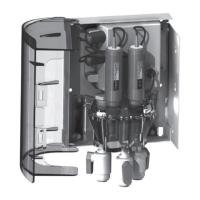Drillandtapa¼"NPTholeusinga7/16"drillbitonthereturnsideofthepoolplumbingataloca-
tion just downstream of the filter, but upstream from the AQL-CL Electrolytic Cell. Use caution not
to tap tapered threads too deeply. Using teflon plumber's tape, install a tubing connector into the
hole. Run flex tubing from the tubing connector to the influent Probe Cell port. Push the flex tubing
all the way into the pressure fitting to seat.
Drillandtapanother¼"NPTholeonthesupplysideofthepoolplumbing.Usecautionnottotap
tapered threads too deeply. Using teflon plumber's tape, install the remaining tubing connector and
run flex tubing to the effluent Probe Cell port. Push the flex tubing all the way into the pressure
fitting to seat.
Cut a 3" length of flex tubing and insert it into the sample stream port. This port can be used to
draw water samples if needed.
If flex tubing needs to be replaced, use only 3/8” UV-resistant cross-linked polyethylene tubing
(PEX).
Installing ORP and pH probes to the Probe Cell
The ORP and pH probes are shipped "wet" in plastic storage caps. It's very important that the
probes remain wet at all times. If the probes are allowed to dry out, they will fail and the HL-CHEM
will be ineffective. After installation, the Probe Cell will ensure that the probes are constantly
exposed to pool water. During periods when the filter pump is off (even extended periods), there
should be sufficient moisture remaining in the Probe Cell to ensure that the probes are protected.
Remove the ORP and pH probes from their plastic storage caps and save the caps for future use.

